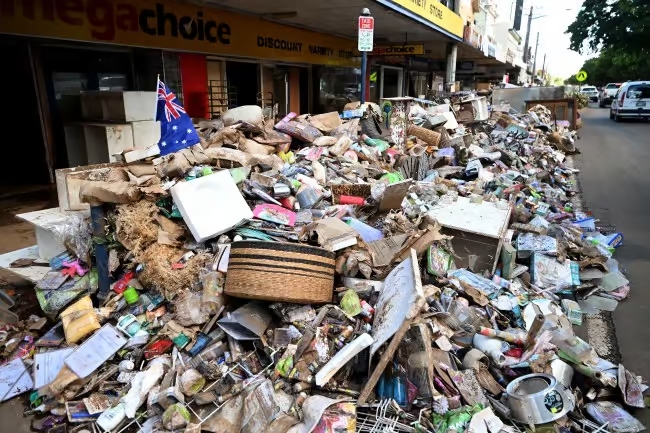
“Catastrophic disasters are here,” says the Australian National University’s Head of Disaster Solutions, Associate Professor Roslyn Prinsley. “We are not planning for them. We have to. We can. It’s urgent”.
Fire. Hail. Drought. Flood. Cyclones. They’re more frequent and more intense than they have been in the past and even the best projections for tackling carbon emissions reaching our atmosphere warn things will get much worse long before they start to get better.
Australia’s traditional approach towards disaster management is not keeping up with these climate change-fuelled disasters, Prinsley says.
“We cannot keep picking up the pieces,” she says. “We need a new way of thinking. We really need to learn how to prepare for and not just recover from natural disasters.”
Australia had its climate emergency “wake-up call” in 2019. And just in case the catastrophic “Black Summer” bushfires weren’t convincing, the unprecedented “Great Deluge” floods of 2022 underscored just how much our climate has already changed.
Grass-roots action
The ANU’s Disaster Solutions team is working with 11 communities to determine how to reduce the impact of almost inevitable future flooding events.
“There’s a huge need for ways to do things better and differently,” Prinsley says. “Quite a lot of communities just don’t want to put in levy walls or anything like that. They want to restore their landscape’s natural capacity to contain water. But they don’t know how.”
One example is a community near Terania Creek north of Lismore in NSW’s Northern Rivers district.

“It was very badly affected by the floods,” she says. “And they were very disappointed with the official sources of information – flood levels, rain levels and so on.”
Rain and river gauges are hooked up to the Bureau of Meteorology’s monitoring system in the area, but these had not been maintained, and as such did not provide accurate information about predicted floods. And then when people upstream could see the torrential rain and flooding heading towards Lismore, they were unable to transmit reports because of downed power lines.
Such damage, says Prinsley, is – by definition – part and parcel of a disaster event.
“So they came to us and asked if we would work with them to build up their own community intelligence network,” she says.
That involves improving resilience through community sentinels reporting from their own rain and stream gauges, solar-powered disaster control centres, CB radio backup communications, and a pre-planned reporting network.
Mitigation matters
Before a solution can be found, the problem needs to be identified and accepted.
Floods are a classic example. At-risk zones can be identified, but they need updating every time natural scrub and forest are cleared, farmers change their crops, and new shopping centre car parks are built.
Insurance premiums and coverage are forcing the issue, however. Insurance Council of Australia Executive Director and CEO Andrew Hall told the Climate Adaptation 2023 conference in Adelaide that Lismore was just one of 12 communities around Australia identified as being at extreme disaster risk.
Prinsley says IAG (Insurance Australia Group) has recently produced a Planned Relocation report as part of a broader risk assessment and mitigation process.
The ANU’s Disaster Solutions unit (DSU) has funding from the National Emergency Management Agency to explore nature-based solutions to flooding. It’s currently working with 10 communities around Australia to test projects such as revegetation and wetlands restoration.
“How do you prove something didn’t happen because you tried to stop it? That’s the hardest thing,” says Prinsley of the challenges facing such disaster mitigation projects.
The answer is through accurate terrain and hydrodynamic and hydrological modelling and measuring, she says.
Systemic hurdles
The Australian Prudential Regulatory Authority has warned that Australia must spend $3.5 billion annually to limit damage from climate-related disasters. It says that waiting to repair the damage after the fact is likely to cost 11 times more.
But those attempting to meet this challenge are finding new hurdles almost every step of the way. Accurate terrain maps and up-to-date hydrological modelling are needed to determine if restoring a patch of scrubland or wetland can slow water flows enough to avert a flood.
Councils involved in the Nature-Based Solutions for Flood Mitigation project already have this data. But they are finding it difficult to access and exploit.
“Each of these locations has already done quite a lot just to understand the potential for floods and how the rivers flow, and rain falls,” says Prinsley.
Consulting agencies are commissioned by district councils.
“But for us to get a hold of that data, we don’t only have to ask the council – they have to go and check with the consultant. We then get tangled up in all these legal agreements. It’s taken us, even in the best-case scenarios, over six months just to get the data to do an analysis.”
That data then has to be refined, calibrated and updated. Only then can it be run through simulation systems capable of assessing the influence of climate change and the resulting change in flood conditions.
“Even if you can do that, communities are finding there’s all these other regulations and reasons why it can’t,” says Prinsley. “Their policies are often set up to stop developers doing things rather than for people trying to fix things.”
It’s just one case study demonstrating the need to develop new tools, systems and strategies to defend lives, property and the environment from the ever-increasing risk of natural hazards.
So far, however, just 2% of the Federal Government’s spending on disaster between 2005 and 2022 has been on resilience projects. The remaining 98% was sunk into recovery and relief efforts.
That bill is expected to reach an annual $73 billion by 2026.
“Those costs are only going to grow,” Prinsley adds. “The only way to reduce them is to invest now in prevention.”
“What’s positive is that the councils and communities we’re working with are really, really keen to do something,” Prinsley says. “It’s just that they need the right support, the right guidance, to do it.”
Some help is available.
The Federal Government recently announced a new program called the Disaster Ready Fund. Over the next 5 years, it plans to commit $1 billion to natural disaster risk reduction projects.
And while Natural Hazards Research Australia (NHRA) provides funding for research, its budget is limited and universities cannot apply directly. NHRA funds the priorities of end-users. “These end-users have obviously got immediate problems they need to solve and don’t have the luxury of thinking a little about the future,” she adds.
What’s needed is a coordinated, centralised national effort to address the challenges of living in 21st-century Australia.
“It’s really frustrating that we have all these scientists at the Defence Science Technology Group (DSTG) group beavering away with $400 million each year looking for new technologies and solutions for defence. But then we only have a few people here and there with hardly any funding trying to find ways to defend ourselves from what is becoming a really concerning trend,” Presley says.
“We need a new way of thinking. That thinking isn’t happening. At the moment, these resilience projects are only being addressed community by community. And we don’t have time to keep not learning from what we’re doing.”